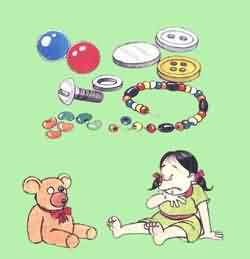|
Introduction Choking is common in young children and it is one of the causes of unintentional death among children. Their smaller airways and windpipe put them at risk of choking. In choking, the obstructed airway or windpipe will prevent oxygen from reaching the lungs and subsequently brain. This can cause death. Any small objects can potentially cause choking. These include foods, house hold items and toy pieces. |
 |
What does a choking episode look like?
The child may or may not have :
- Sudden onset of wheezing
- Abnormal breathing sound (whistling)
- Clutch the throat
- Bluish discolouration around mouth and lips
- Breathe rapidly
- Flaring of the nostrils with each breath
- Loss of consciousness
- Stop breathing
Sometimes a child may aspirate without choking (such as with peanuts) if the object aspirated is fine enough. He may have :
- Persistent cough
- Wheezing episodes
- No symptoms
Complications
- Infection of the lung i.e. pneumonia.
- Brain damage from lack of oxygen.
- Death from severe pneumonia or inflammation of the lungs or lack of oxygen to the brain.
What to do if your child chokes?
If your child chokes :
- DO’s
- Wait for the child to cough.
- Call for help.
- Open mouth very gently – remove object only if you see it clearly.
- If unsuccessful, slap the infant firmly 5 times between the shoulder blades with the heel of your hand and the child’s head held lower than the body.
- DON’Ts
- Do not sweep your finger blindly into the child’s mouth.
- Do not pull the neck backwards.
If the infant stops breathing and remains blue or unconscious, start Cardio-Pulmonary Resuscitation (CPR) while waiting for expert help.
FOR AN OLDER CHILD.
- Make the child stand if conscious.
- Position yourself behind the child.
- Perform Heimlich manouvre.
If child is unconscious : Perform CPR.
Prevention
- Do not allow your child to eat while they are playing.
- Prepare the food into bite size pieces.
- Keep floors, tables and areas where the child plays free of small objects.
Eg : buttons, marbles, coins, pins and beads. - Avoid giving foods that can easily cause choking such as peanuts, candy and pop corn.
- Avoid giving toys with small parts.
- Learn first aid on how and what to do if your child is choked.
| Last reviewed | : | 23 August 2019 |
| Content Writer | : | Dr. Norraliza Md Zain |
| Reviewer | : | Dr. Mohamad Hamim b. Mohamad Hanifah |







